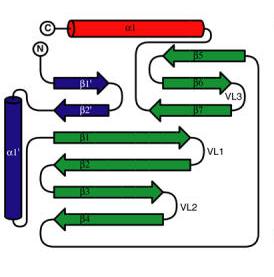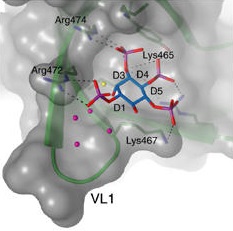Sandbox Reserved 822
From Proteopedia
| Line 30: | Line 30: | ||
== Ligand Interaction == | == Ligand Interaction == | ||
[[Image:1w1h Ins(1,3,4,5)P4 binding.jpg|right|320px|thumb|Fig.2 Ins(1,3,4,5)P<sub>4</sub> binding to the PH domain of PDK1. Interactions of Ins(1,3,4,5)P<sub>4</sub> (marine) with protein residues (green) are shown in a stereo representation. Hydrogen bonds are indicated as black dotted lines. Conserved water molecules are shown as yellow spheres, not conserved water molecules are coloured magenta. <ref name="Structural"> PMID: 524332 </ref>]] | [[Image:1w1h Ins(1,3,4,5)P4 binding.jpg|right|320px|thumb|Fig.2 Ins(1,3,4,5)P<sub>4</sub> binding to the PH domain of PDK1. Interactions of Ins(1,3,4,5)P<sub>4</sub> (marine) with protein residues (green) are shown in a stereo representation. Hydrogen bonds are indicated as black dotted lines. Conserved water molecules are shown as yellow spheres, not conserved water molecules are coloured magenta. <ref name="Structural"> PMID: 524332 </ref>]] | ||
| - | The PH domain of PDK1 binds inositol phosphates and phosphatidylinositol phosphates with different affinities depending on the phosphorylation state of the molecules. These interactions target PDK1 to particular locations inside the cell and are therefore crucial for the flawless execution of signaling pathways in which PDK1 is involved. | + | The PH domain of PDK1 binds inositol phosphates and phosphatidylinositol phosphates with different affinities depending on the phosphorylation state of the molecules. These interactions target PDK1 to particular locations inside the cell and are therefore crucial for the flawless execution of signaling pathways in which PDK1 is involved.<ref name="Structural" /> |
=== Binding site === | === Binding site === | ||
| - | The <scene name='56/568020/Active_site/1'>binding site</scene> is formed by VL 1-3 which create a shallow, positively charged pocket at the open end of the β barrel. The structure was determined from a crystal grown in the presence of Ins(1,3,4,5)P<sub>4</sub>, which is the head group of PtdIns(3,4,5)P<sub>3</sub>. The phosphoinositide-binding site is lined by positively charged residues which contact the phosphates of Ins(1,3,4,5)P<sub>4</sub> by forming up to 11 hydrogen bonds. <scene name='56/568020/Arg472/1'>Arg472</scene> forms two hydrogen bonds to the phosphate in the D1 position (D1-phosphate). <scene name='56/568020/Argandlys/1'>Arg474 and Lys465</scene> contact the D3-phosphate with three hydrogen bonds in total (two for Arg474, one for Lys465). <scene name='56/568020/Lys495/1'>Lys495</scene> is also in close proximity (4.4 Å) of the D3-phosphate and is able to interact with it. <scene name='56/568020/Lys_tyr_and_arg/2'>Lys465, Tyr486 and Arg521</scene> form up to four hydrogen bonds to the D4-phosphate. The D5-phosphate is contacted by <scene name='56/568020/Lys467/1'>Lys467</scene> with one hydrogen bond. The D2- and D6-hydroxy groups show no direct interactions with the protein. | + | The <scene name='56/568020/Active_site/1'>binding site</scene> is formed by VL 1-3 which create a shallow, positively charged pocket at the open end of the β barrel. The structure was determined from a crystal grown in the presence of Ins(1,3,4,5)P<sub>4</sub>, which is the head group of PtdIns(3,4,5)P<sub>3</sub>. The phosphoinositide-binding site is lined by positively charged residues which contact the phosphates of Ins(1,3,4,5)P<sub>4</sub> by forming up to 11 hydrogen bonds. <scene name='56/568020/Arg472/1'>Arg472</scene> forms two hydrogen bonds to the phosphate in the D1 position (D1-phosphate). <scene name='56/568020/Argandlys/1'>Arg474 and Lys465</scene> contact the D3-phosphate with three hydrogen bonds in total (two for Arg474, one for Lys465). <scene name='56/568020/Lys495/1'>Lys495</scene> is also in close proximity (4.4 Å) of the D3-phosphate and is able to interact with it. <scene name='56/568020/Lys_tyr_and_arg/2'>Lys465, Tyr486 and Arg521</scene> form up to four hydrogen bonds to the D4-phosphate. The D5-phosphate is contacted by <scene name='56/568020/Lys467/1'>Lys467</scene> with one hydrogen bond. The D2- and D6-hydroxy groups show no direct interactions with the protein.<ref name="Structural" /> |
Revision as of 11:55, 9 January 2014
| This Sandbox is Reserved from 06/12/2018, through 30/06/2019 for use in the course "Structural Biology" taught by Bruno Kieffer at the University of Strasbourg, ESBS. This reservation includes Sandbox Reserved 1480 through Sandbox Reserved 1543. |
To get started:
More help: Help:Editing |
Contents |
Description
1W1H is a 4 chain structure of the human pleckstrin homology (PH) domain of the 3-phosphoinositide-dependent protein kinase 1 (PDK1), which plays a various role in PI3K signaling pathways.
PDK1 contains 556 amino acids and phosphorylates and activates at least 24 Proteins of the AGC (cAMP-dependent, cGMP-dependent, protein kinase C (PKC)) family of protein kinases. It therefore consists of a N-terminal Ser/Thr kinase catalytic domain (residues 71-359) and the C-terminal pleckstrin homology (PH) domain (residues 459-550).
PDK1 is activated by binding of its PH domain to specific target molecules like phosphoinositides or phosphoatityl inositides and can then interact with its target substrates.
Even though the targeting of PDK1 to specific locations of the cell is not fully understand in detail, it has been proven that the binding of its PH domain to target molecules plays a central role in this process.[1]
Structure
The structure 1W1H has in total 4 chains. These are represented by 1 sequence-unique entity (for reasons of clarity all green links show therefore only one chain as a representation for all four chains). The PH domain of PDK1 reveals a structural variation of a standard PH domain fold with an additional 'bud' at the N-terminus.

The standard PH domain fold consists of mainly three different sections:
- One section is a formed by residues 456-530 (see Fig.1, green section). This structure is formed by two, almost orthogonal, β sheets, one consisting of four (β1 - β4) and one of three (β5 - β7) stand.
- One side of the barrel is blocked by a (see Fig.1, red section).
- On the other side of the barrel three variable loops (VL 1-3) form a bowl-like structure which is lined by positively charged residues, consituting the phosphoinositide-binding site.
The PH domain of PDK1 possesses an additional extension () N-terminal to the standard PH domain fold (see Fig.1 blue section). This bud forms two additional β strands and one α helix and is an integral part of the overall fold. The two β strands β1' and β2'extend the β1 - β4 sheet in an antiparallel fashion through the formation of β sheet hydrogen bonds between β2'and β1. The α helix packs against this newly formed six stranded β sheet forming an additional outside of the standard PH domain fold. The bud binds to the β1 - β4 sheet by several additional hydrophobic contacts and buries more than 30% of the surface of the standard PH domain fold. [1]
Ligand Interaction

The PH domain of PDK1 binds inositol phosphates and phosphatidylinositol phosphates with different affinities depending on the phosphorylation state of the molecules. These interactions target PDK1 to particular locations inside the cell and are therefore crucial for the flawless execution of signaling pathways in which PDK1 is involved.[1]
Binding site
The is formed by VL 1-3 which create a shallow, positively charged pocket at the open end of the β barrel. The structure was determined from a crystal grown in the presence of Ins(1,3,4,5)P4, which is the head group of PtdIns(3,4,5)P3. The phosphoinositide-binding site is lined by positively charged residues which contact the phosphates of Ins(1,3,4,5)P4 by forming up to 11 hydrogen bonds. forms two hydrogen bonds to the phosphate in the D1 position (D1-phosphate). contact the D3-phosphate with three hydrogen bonds in total (two for Arg474, one for Lys465). is also in close proximity (4.4 Å) of the D3-phosphate and is able to interact with it. form up to four hydrogen bonds to the D4-phosphate. The D5-phosphate is contacted by with one hydrogen bond. The D2- and D6-hydroxy groups show no direct interactions with the protein.[1]
Importance for Signaling Pathways
Once activated by growth factors, various local responses, such as cell growth, cell survival and cell movement are regulated by the highly conserved PDK1 pathway.
Therefore PDK1 binds to the lipid products of PI3K, PtdIns(3,4,5)P3 and PtdIns(3,4)P2 (see 'Ligand Interaction'). Once localized to the plasma membrane PDK1 can phosphorylate PKB/Akt and thereby activate mTOR, which plays a major role in ageing mechanisms and Alzheimer’s disease. Other tumor supressors such as the phosphatidylinositol 3′-phosphatase PTEN act to down-regulate signaling from PI3K to PDK1 and PKB as well. [2]
Some other substrates of PDK1 are usually activated when the lipid-binding function of the protein is inhibited. Hence, not all PDK1 mediated reactions depend necessarily on the PH domain of PDK1. [3]
References
- ↑ 1.0 1.1 1.2 1.3 1.4 1.5 Rostad H, Simonsen S, Nitter-Hauge S. Combined aortic and mitral valve replacement. A randomized study comparing the Bjork-Shiley and Lillehei-Kaster disc valve. Thorac Cardiovasc Surg. 1979 Oct;27(5):308-12. PMID:524332 doi:http://dx.doi.org/10.1055/s-0028-1096265
- ↑ Hemmings, Brian A., and David F. Restuccia. "PI3K-PKB/Akt Pathway." Cold Spring Harbor Perspectives in Biology 4.9 (2012) DOI:10.1101/cshperspect.a011189
- ↑ Scheid, Michael P., Michael Parsons, and James R. Woodgett. "Phosphoinositide-dependent phosphorylation of PDK1 regulates nuclear translocation." Molecular and cellular biology 25.6 (2005): 2347-2363. DOI:10.1128/MCB.25.6.2347-2363.2005
Contributors
Klesse Ramona, Gerbeth Lorenz

